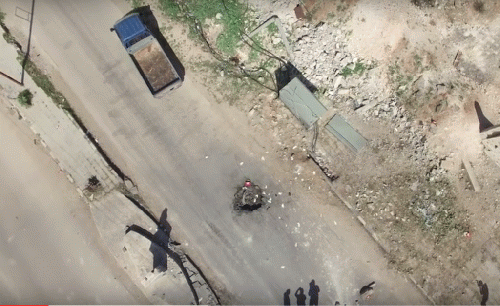The New York Times published a piece that was similar. "Syria Conspiracy Theories Flourish, at Both Ends Of the Spectrum" emphasized that websites like Infowars called the alleged chemical attack a "false flag" while "liberal blogs have pointed to the strike as evidence of 'wag the dog' diversion tactics."
The Times wrongly attributed "speculation" to Information Clearing House, which is an aggregator of commentary. The column cited came from Paul Antonopoulos, deputy editor of Al-Masdar News, which is frequently accused of being a pro-Syrian government media outlet. So the Times fumbled this attempt to set the confines of what is acceptable discussion around the alleged chemical attack.
It is lazy and stupid to suggest skepticism originates from the fringes, however, let's admit such an argument does serve the interests of the Trump administration and military industrial-complex quite well.
One of the most compelling pieces questioning the official version of events was written by Scott Ritter, a former United Nations weapons inspector who prior to the U.S. invasion of Iraq said there was no evidence Iraq possessed weapons of mass destruction.
Ritter notes sarin is "odorless, colorless material, dispersed as either a liquid or vapor." Individuals who said they were eyewitnesses spoke of a "pungent odor" and "blue-yellow" clouds that more closely matched chlorine gas. He also refers to the images of "White Helmet" rescuers treating victims infected by the gas and questions why they were handling victims without protective clothing that would prevent military-grade sarin from harming them.
At least 20 victims of the incident were treated in Turkish hospitals and three died there. "According to the Turkish Justice Minister, autopsies conducted on the bodies confirm that the cause of death was exposure to chemical agents. The World Health Organization has indicated that the symptoms of the Khan Sheikhoun victims are consistent with both Sarin and Chlorine exposure."
"American media outlets have latched onto the Turkish and WHO statements as 'proof' of Syrian government involvement; however, any exposure to the chlorine/white phosphorous blend associated with al Nusra chemical weapons would produce similar symptoms," Ritter contends.
"Moreover, if al Nusra was replicating the type of low-grade Sarin it employed at Ghouta in 2013 at Khan Sheikhoun, it is highly likely that some of the victims in question would exhibit Sarin-like symptoms," Ritters asserts. "Blood samples taken from the victims could provide a more precise readout of the specific chemical exposure involved; such samples have allegedly been collected by Al Nusra-affiliated personnel, and turned over to international investigators (the notion that any serious investigatory body would allow Al Nusra to provide forensic evidence in support of an investigation where it is one of only two potential culprits is mindboggling, but that is precisely what has happened)."
Yet, as Ritter acknowledges, the Trump administration acted before the samples were processed.
Ritter also soberly considers the possibility that a building bombed on April 4 was producing or storing chemical weapons. He notes that a pro-ISIS group, Liwa al Aqsa was engaged in a violent struggle against al Nusra up until February 2017, and the Russian Ministry of Defense previously claimed the group used facilities near Khan Sheikhoun to "manufacture crude chemical shells and landmines intended for ISIS forces fighting in Iraq."
"Al Nusra has a long history of manufacturing and employing crude chemical weapons; the 2013 chemical attack on Ghouta made use of low-grade Sarin nerve agent locally synthesized, while attacks in and around Aleppo in 2016 made use of a chlorine/white phosphorous blend," Ritter wrote. "If the Russians are correct, and the building bombed in Khan Sheikhoun on the morning of April 4, 2017 was producing and/or storing chemical weapons, the probability that viable agent and other toxic contaminants were dispersed into the surrounding neighborhood, and further disseminated by the prevailing wind, is high.
Ritter and several other former U.S. intelligence officials from the Veteran Intelligence Professionals for Sanity (VIPS) issued a "memo" questioning whether a chemical weapons attack occurred.
These individuals are not a bunch of cranks opportunistically out to win over subscribers to some website by providing them baseless and convoluted theories that will resonate with an embittered audience. The group was established in January 2003 after it was concluded Vice President Dick Cheney and Secretary of Defense Donald Rumsfeld ordered their former colleagues to manufacture intelligence for war in Iraq.
The former officials who signed on to the memo urged, as they did after Secretary of State Colin Powell's infamous speech to the United Nations, that Trump go "beyond the circle of those advisers clearly bent on a war for which we see no compelling reason and from which we believe the unintended consequences are likely to be catastrophic."
White House Report Fails To Resolve Key QuestionsOn April 11, the White House released a white paper that supposedly contained the administration's best evidence that Assad's regime was behind the alleged chemical attack. Most U.S. press apparently took this as another indication that there was no reason to doubt that Assad gassed civilians. But it fails to resolve many of the questions that remain outstanding.
(Note: You can view every article as one long page if you sign up as an Advocate Member, or higher).






